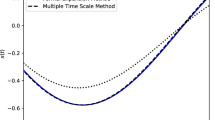Abstract:
Ground state of the dissipative two-state system is investigated by means of the Lanczos diagonalization method. We adopted the Hilbert-space-reduction scheme proposed by Zhang, Jeckelmann and White so as to reduce the overwhelming reservoir Hilbert space to being tractable in computers. Both the implementation of the algorithm and the precision are reported in detail. We evaluate the dynamical susceptibility (resolvent) with the continued-fraction-expansion formula. Through analysing the resolvent over a frequency range, which is often called “interesting” frequency, we obtain the damping rate and the oscillation frequency. Our results agree with those of a recent quantum Monte-Carlo study, which concludes that the critical dissipation from oscillatory to over-damped behavior decreases as the tunneling amplitude is strengthened.
Similar content being viewed by others
Author information
Authors and Affiliations
Additional information
Received 18 January 1999
Rights and permissions
About this article
Cite this article
Nishiyama, Y. Numerical analysis of the dissipative two-state system with the density-matrix Hilbert-space-reduction algorithm. Eur. Phys. J. B 12, 547–554 (1999). https://doi.org/10.1007/s100510051037
Issue Date:
DOI: https://doi.org/10.1007/s100510051037




